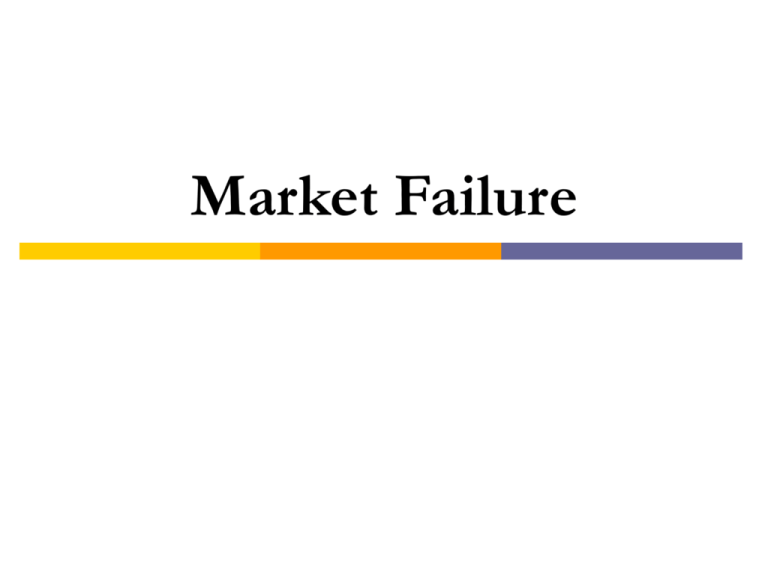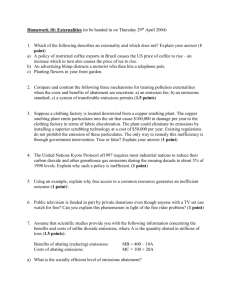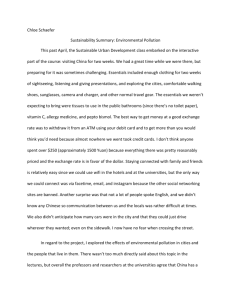Public Finance - Marietta College
advertisement

Market Failure All pollution should be eliminated. Strongly Agree Agree Neutral Disagree Strongly Disagree a) b) c) d) e) 1 2 3 4 5 0% 0% 0% 0% 0% a) b) c) d) e) Market Failure When the market does not efficiently allocate resources Either too much or too little is produced Monopoly Externalities Public goods Justification for government intervention? Externalities Occur when decision makers do not consider all costs (or benefits) of their actions Two views “Spillover effects” A. C. Pigou Ronald Coase Pigouvian Approach Social Cost = Private Cost + External Cost Price of beer Hangover Damage to others Boorish behavior Drinking Alcohol Cashmere Externalities Pollution Ssocial Free Market: P1, Q1 Optimal Outcome: P2, Q2 $ Sprivate P2 P1 External cost Free market overproduces goods that generate a negative externality D1 How can society achieve social optimum? Impose tax = marginal external cost Internalize the externality! Q2 Q 1 “Pigou tax” steel The efficient output will be less than the free market output when: d) a) 0% 1 2 3 4 5 0% 0% 0% d) c) c) b) Marginal social cost and marginal private cost are equal Marginal social cost is greater than marginal private cost Marginal social benefit and marginal private benefit are equal Marginal social benefit is greater than marginal private benefit b) a) Education Free Market: P1, Q1 Optimal Outcome: P2, Q2 $ S1 P2 External benefit P1 Free market underproduces goods that generate a positive externality Dsocial Dprivate How can society achieve social optimum? Provide subsidy = marginal external benefit Q1 Q2 Years of College If there is a positive externality, the: a) social benefits will be greater than the private benefits external benefits will be greater than the social benefits social benefits will be equal to the private benefits private benefits will be greater than the social benefits b) c) d) 1 2 3 4 5 fit s w i.. w i.. ne be at e pr iv ci al be ne fit s ne fit ... be so te rn al ex so ci al be ne fit s w ... 0% 0% 0% 0% A consequence of a negative consumption externality is that social benefits are ______ than private benefits, and the socially optimal level of output is ______ than the private level of output. a) b) c) d) greater; greater. greater; less. less; less. less; greater. 1 2 3 4 5 ;l le ss te r. ;g ss le re a es s. ss . le te r; gr ea gr ea te r; gr ea te r . 0% 0% 0% 0% Pollution Worksheet Optimal pollution for Marietta-Parkersburg area is 60,000 units of emissions Abatement Cost Cars: $5 Utilities: $10 Factories: $20 Controlling pollution through: Standards Taxes Tradable Permits Standards “Command-and-Control” approach Emission standards Technology standards Set a maximum emissions of 20,000 units per source: SOURCE EMISSIONS EMISSIONS ABATED ABATEMENT COSTS CARS 20,000 0 0 UTILITIES 20,000 10,000 $100,000 FACTORIES 20,000 20,000 $400,000 60,000 30,000 $500,000 TOTAL Standards Require each source to cut emissions by 10,000 units: SOURCE EMISSIONS EMISSIONS ABATED ABATEMENT COSTS CARS 10,000 10,000 $50,000 UTILITIES 20,000 10,000 $100,000 FACTORIES 30,000 10,000 $200,000 60,000 30,000 $350,000 TOTAL Standards Require each source to cut emissions by 1/3: SOURCE EMISSIONS EMISSIONS ABATED ABATEMENT COSTS CARS 13,333 6,667 $ 33,335 UTILITIES 20,000 10,000 $100,000 FACTORIES 26,667 13,333 $266,660 60,000 30,000 $399,995 TOTAL Standards Cost minimizing strategy of reducing emissions by 30,000 units. SOURCE EMISSIONS EMISSIONS ABATED ABATEMENT COSTS 0 20,000 $100,000 UTILITIES 20,000 10,000 $100,000 FACTORIES 40,000 0 0 60,000 30,000 $200,000 CARS TOTAL “$200,000 Solution” Taxes A tax of t = $6 per unit of pollution is imposed: SOURCE EMISSIONS EMISSIONS ABATED ABATEMENT COSTS TAX COSTS 0 20,000 $100,000 0 UTILITIES 30,000 0 0 $180,000 FACTORIES 40,000 0 0 $240,000 70,000 20,000 $100,000 $420,000 CARS TOTAL Taxes A tax of t = $11 per unit of pollution is imposed: SOURCE EMISSIONS EMISSIONS ABATED ABATEMENT COSTS TAX COSTS CARS 0 20,000 $100,000 0 UTILITIES 0 30,000 $300,000 0 40,000 0 0 $440,000 40,000 50,000 $400,000 $440,000 FACTORIES TOTAL Taxes A tax of t = $10.05 per unit of pollution is imposed only on factories for each unit of pollution over the 60,000 limit, regardless of the source. SOURCE EMISSIONS EMISSIONS ABATED ABATEMENT COSTS TAX COSTS CARS 20,000 0 0 0 UTILITIES 30,000 0 0 0 FACTORIES 40,000 0 0 $301,500 90,000 0 0 $301,500 TOTAL If transactions costs low enough, then $200,000 solution can be achieved through private bargaining. Cap and Trade Program S $ $20 F Abatement Cost P = $10 Q = 60,000 U $10 C $5 D 40 60 70 90 permits 2008 Spot Auction 2008 7-yr Advance Auction “$200,000 Solution” Coasian Approach Externalities are due to incomplete property rights assignment “It takes two to tango” Aunt Linda and the Nudist Rifle River Aunt Linda $1500 Nudist $1200 $1000 Judge rules in favor of Aunt Linda Fence comes down Judge rules in favor of Nudist Fence comes down 2 rulings (Linda pays Nudist) Coasian Approach Externalities are due to incomplete assignment of property rights Coase Theorem If property rights are well-defined and transactions costs are low enough, then private bargaining can result in an efficient allocation of resources. Corollary Allocation of resources does not depend on initial assignment of property rights. Pollution Revisited Cheshire, Ohio v. AEP AEP paid $20 million to buy the 221-resident town in 2002 A factory's production process creates sludge that pours into a river. This sludge makes it difficult to fish in the river, increasing the costs of the local fishermen by $5000. The factory can install a water filter system for $4100, and the fishermen can utilize a weighted fishing net system (to get under the sludge) for $3250. Both systems would remedy the sludge damage to the fishermen. Nets: $3250 Factory Damage: $5000 a) Transactions costs low and factory is not liable for damage? b) Transactions costs low and factory is liable for damage? c) Transactions costs high and factory is liable for damage? Filter: $4100 Characteristics of Goods Excludability: can you be excluded from consuming the good? Rivalry: does my consumption hinder your consumption? Excludable NonExcludable Rival Non-rival Private Goods Artificially Scarce Goods Common Resources Public Goods Government Provided Goods and Services Schools Roads Police Courts Fire Department Water Library Health Care Transportation National Defense Social Security Medicare Postal Service FBI, CIA, SEC, FTC, FCC, NSF, FDA, ARC, FDIC, NLRB, HUD National Defense Federal Government spent $670 billion in 2007 Per capita expenditure $670,000,000,000 $2,233 300,000,000 How do we pay for this? National Defense Telethon? Taxes! Public Goods Problems “free-rider” problem Under-provision by free market Social Optimum requires: MSB = MSC Must find some way to aggregate individual marginal benefits Fireworks in Marietta Quantity Julia’s MB Seita’s MB Leah’s MB ΣMB MC Total Benefit Total Cost Net Benefits 10 $8 $5 $9 $22 $10 $22 $10 $12 20 $7 $4 $8 $19 $10 $41 $20 $21 30 $6 $3 $6 $15 $10 $56 $30 $26 40 $5 $2 $4 $11 $10 $67 $40 $27 50 $4 $1 $2 $7 $10 $74 $50 $24 60 $3 $0 $1 $4 $10 $78 $60 $18 The table below shows the marginal benefit from submarines for the only two citizens of a country. Submarines are a public good. If submarines cost $175 a piece to produce, what is the efficient quantity of submarines? f) 1 2 3 4 1 150 75 2 100 50 3 50 25 4 10 0 5 0 5 0% 0% 0% 0% 0% 0% 5 e) 100 4 d) Marginal benefit (dollars per sub) 3 c) Quantity 2 b) 0 1 2 3 4 5 Marginal benefit (dollars per sub) 1 a) Bobby 0 Kathy Common Resources Non-excludable Rival in consumption * overuse * congestion “Tragedy of the commons” Examples Elephants in Africa Fish in the sea Bison in America CITES Campfire Artificially Scarce Goods Excludable Non-Rival Marginal Cost of provision is zero $ Examples Software Pay-per-view movies pharmaceuticals P1 MR Q1 D Q0 MC Drugs








